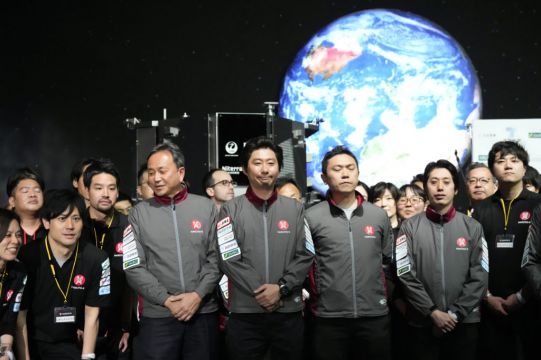A Japanese company’s spacecraft has apparently crashed while attempting to land on the moon, losing contact moments before touchdown and sending flight controllers scrambling to figure out what happened.
More than six hours after communication ceased, the Tokyo company ispace finally confirmed what everyone had suspected, saying there was “a high probability” that the lander had slammed into the moon.
It was a disappointing setback for ispace, which after a four-and-a-half-month mission had been on the verge of doing what only three countries have done: successfully land a spacecraft on the moon.
Takeshi Hakamada, founder and chief executive of ispace, held out hope even after contact was lost as the lander descended the final 33 feet (10 metres), traveling around 16mph (25kph). Flight controllers peered at their screens in Tokyo as minutes went by with only silence from the moon.
A grim-faced team surrounded Mr Hakamada as he announced: “We have to assume that we could not complete the landing on the lunar surface.”
Official word finally came in a statement: “It has been determined that there is a high probability that the lander eventually made a hard landing on the moon’s surface.”
If all had gone well, ispace would have been the first private business to pull off a lunar landing. Mr Hakamada vowed to try again, saying a second moonshot is already in the works for next year.
Only three governments have successfully touched down on the moon: Russia, the United States and China. An Israeli non-profit tried to land on the moon in 2019, but its spacecraft was destroyed on impact.
“If space is hard, landing is harder,” tweeted Laurie Leshin, director of Nasa’s Jet Propulsion Laboratory. “I know from personal experience how awful this feels.”
If space is hard, landing is harder. My heart goes out to the @ispace_inc team. I know from personal experience how awful this feels. Mars Polar Lander was nearly 25 yrs ago and it still hurts. I know they will learn fast and move forward! https://t.co/v8tCKkDPsD
Advertisement— Laurie Leshin (@LaurieofMars) April 25, 2023
Ms Leshin worked on Nasa’s Mars Polar lander that crashed on the red planet in 1999.
The seven-foot (2.3-metre) Japanese lander carried a mini lunar rover for the United Arab Emirates and a toylike robot from Japan designed to roll around in the moon dust. There were also items from private customers on board.
Named Hakuto, Japanese for white rabbit, the spacecraft had targeted Atlas crater in the northeastern section of the moon’s near side, more than 50 miles (87 kilometres) across and just over one mile (two kilometres) deep.
It took a long, roundabout route to the moon following its December lift-off, beaming back photos of Earth along the way. The lander entered lunar orbit on March 21st.
Founded in 2010, ispace hopes to start turning a profit as a one-way taxi service to the moon for other businesses and organisations.
“We will keep going, never quit lunar quest,” Mr Hakamada said.
For this test flight, the two main experiments were government-sponsored: the UAE’s 22-pound (10-kilogram) rover Rashid, named after Dubai’s royal family, and the Japanese Space Agency’s orange-sized sphere designed to transform into a wheeled robot on the moon.
With a science satellite already around Mars and an astronaut aboard the International Space Station, the UAE was seeking to extend its presence to the moon.







